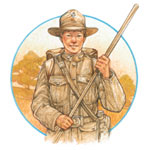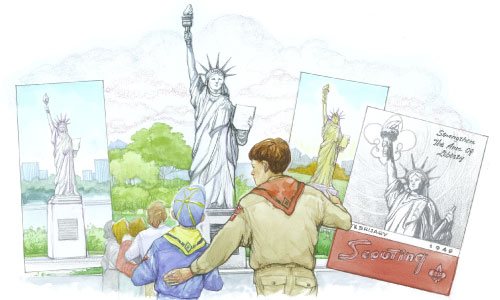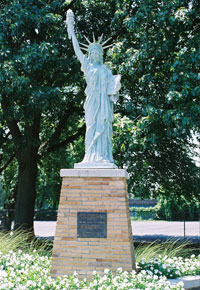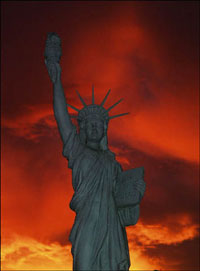
The Way It Was
- As the Cold War Loomed Large, Scouting Celebrated America’s Tradition of Liberty and Freedom
- The Way it Was in previous issues
By Marti Attoun
Little Sisters of Liberty
To help promote the BSA’s 40th anniversary theme of “Strengthen the Arm of Liberty,” 200 small versions of the Statue of Liberty were placed in communities across the country in the early 1950’s. A recent campaign has helped restore many of these long-neglected statues.
 |
On May 27, 1950, nearly 1,000 Boy Scouts marched through downtown Cheyenne, Wyo., on their way to the state capitol grounds to dedicate an eight-foot-tall replica of the Statue of Liberty.
“This should be a proud day for Wyoming,” Gov. Arthur Crane told the crowd attending the ceremony. “First, there are patriotic citizens who voluntarily give of their time to guide and direct the Scouts of Cheyenne and vicinity. Secondly, there are youthful citizens faithfully following the Scout Oath. Thirdly, they have chosen the objective for the year, ‘Strengthen the Arm of Liberty.’”
Between 1949 and 1952, in town after town across America, similar celebrations took place as Scouts dedicated more than 200 of the copper “Little Sisters of Liberty.”
 Shawnee Mission North High School in Overland Park, Kan., is home to this replica of Lady Liberty. |
The statues were located on capitol grounds, courthouse lawns, and main streets; in city parks, schoolyards, and libraries; and at Scout camps — all as part of Scouting’s 40th anniversary theme, “Strengthen the Arm of Liberty.”
Jack P. Whitaker, a Kansas City businessman and commissioner for the local Boy Scout council, originated the project after seeing a dedication of a Statue of Liberty replica made of chicken wire and concrete in Spirit Lake, Iowa.
Whitaker paid $3,500 to have an original mold made for the smaller Statues of Liberty. Then the Friedley-Voshardt Company in Chicago made the stamped-copper replicas. Each statue included more than 40 sheets of copper, about the thickness of a nickel, with a wooden frame on the inside.
The statues were then sold for a reported $300 to $350 each to Scout troops, who presented them to cities and towns in 39 states, Guam, Puerto Rico, the Canal Zone, and the Philippines.
Local communities provided pedestals, which were often quite elaborate and added several feet to the overall height of the statue. Landscaping, too, sometimes graced the statues.
No official count or record was kept on the project and, as the decades wore on, many of the little Statues of Liberty suffered the effects of time.
Weather and vandalism took a toll. Spikes were broken from the crown and the torch-carrying arm often was damaged. While some cities faithfully restored the statues, others simply junked them.
That all changed, starting in 1998, thanks to Troop 101 of Cheyenne, Wyo., chartered to the Cheyenne Lions Club. The troop launched a national treasure hunt to locate the remaining statues and restore interest in the original project.
The troop set up a Web site (troop101.thescouts.com/liberty/) and invited visitors to send in photos and information about the statues in their hometowns.
Kevin Rice, the site’s volunteer coordinator, said the troop took on the project after digging into its own history and discovering newspaper clippings from 1950 about Cheyenne’s statue. The boys wondered how many other cities had statues, and adult leader Pat Madigan suggested trying to get a photo of as many statues as possible.
 This "Little Sister of Liberty" stands on the north grounds of the Texas State Capitol in Austin. |
To date, the site includes nearly 100 photos of Little Sisters of Liberty, many photographed by Scouts and others from across the United States and e-mailed to Troop 101.
The site also includes a 1951 list of more than 200 communities that originally received statues, to which a note has been added regarding each statue’s current location, if known.
Involvement with the Web site was just the beginning of Leland Duck’s interest. He decided to make the statue restoration program in Cheyenne his Eagle service project.
“After 9-11, I felt that it was time to revive the Boy Scout’s campaign of 1950,” said Leland.
The task of restoring the statues wouldn’t be easy, if Cheyenne’s Little Sister of Liberty was any example. It had deteriorated over the years, lost all the spikes from its crown, and at some point had been painted gold, Leland reported.
Because the statue was located on state government grounds, Leland talked to officials about the importance of restoring the statue and sought estimates for the work, which came to about $15,000.
During a city fall festival, Leland manned an information booth about the statue and sold his own crafted stained-glass ornaments to earn money to apply for the restoration.
“This is one of the biggest Eagle Scout service projects we’ve had,” said Kevin Rice. “Leland talked to the mayor, the governor, and the secretary of state, because our statue was on state property and we couldn’t just go in and fix it. It has to be conserved according to certain standards. This is quite a leadership project.”
More than 50 years have passed since the BSA’s “Strengthen the Arm of Liberty” campaign, but in Cheyenne and elsewhere, the statues that once symbolized that theme across the country are again helping a nation to remember its ideals and freedoms.
Freelance writer Marti Attoun lives in Joplin, Mo.
As the Cold War Loomed Large, Scouting Celebrated America’s Tradition of Liberty and FreedomIn February 1949, the Boy Scouts of America launched a two-year “Strengthen the Arm of Liberty” campaign with a torch-lighting ceremony beneath the Statue of Liberty in New York Harbor. Similar ceremonies were conducted from coast to coast. The need for such a program was greater than ever. The post-World War II cold war with the Soviet Union and other communist nations had already seen a confrontation in Europe with the Berlin Airlift. In less than two years, a shooting war would erupt in Korea. “Whether the future is to be one of freedom or despotism depends chiefly on how our young people develop,” warned BSA President Amory Houghton in an article in Scouting magazine announcing the new program, which would coincide with the BSA’s 40th anniversary in 1950. To carry out the program, packs, troops, and Explorer posts set goals in the areas of leadership, program, and membership. The next two years saw a variety of special activities and events, local and national. These included the 1950 Boy Scout Jamboree at Valley Forge, Pa., as well as the program that resulted in the distribution of more than 200 replicas of the Statue of Liberty nationwide. In the December 1950 issue of Scouting magazine, the BSA concluded that “No national program of the Boy Scouts of America has ever met with such outstanding and universal acceptance as our 40th Anniversary Crusade to Strengthen the Arm of Liberty.” The effort had been so successful, in fact, that the National Executive Board voted to continue it another year. “It was because of the darkening world situation that we initiated the Crusade to Strengthen the Arm of Liberty,” explained Chief Scout Executive Arthur Schuck in the February 1951 issue of Scouting. “And it was because of increasingly serious world developments that the National Board voted to extend that Crusade through 1951. “…With an ever more devoted leadership, with a constantly improving program, and a membership which becomes larger and stronger hour by hour, we can and will do our best to serve our country well in this time of great need.” —Jon C. Halter |
October 2007 Table of Contents
Copyright © 2007 by the Boy Scouts of America. All rights thereunder reserved; anything appearing in Scouting magazine or on its Web site may not be reprinted either wholly or in part without written permission. Because of freedom given authors, opinions may not reflect official concurrence.